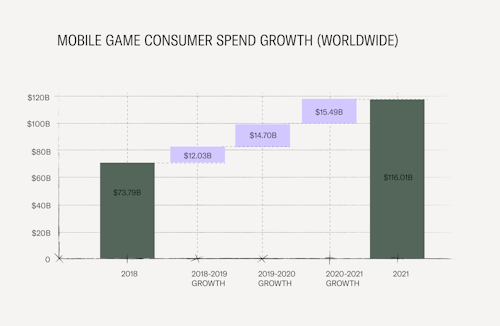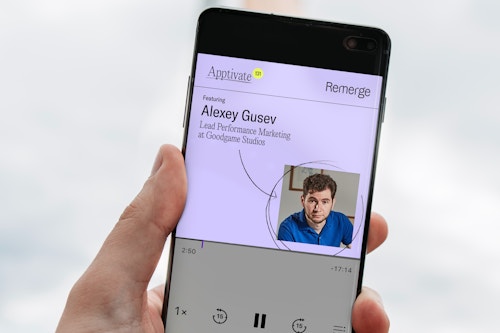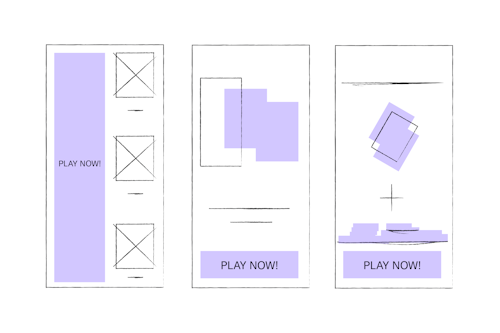How do major gaming studios retarget paying users?
July 18, 2022

The revenue potential of the mobile gaming sector continues to grow. This development has led to increased competition as new apps constantly enter the market and battle it out for peoples' attention.
As a result, it’s becoming even more expensive to acquire new users. The average Cost Per Install (CPI) for casual gaming apps, one of the most popular subcategories in the industry, is evidence of this trend. From 2020 to 2021, the average CPI for casual gaming apps was $1.96, an increase of 45% when compared to 2019 to 2020.
We revisit some of our Apptivate podcast episodes with Playtika and Scopely to share what successful gaming studios do after they have attracted new users to their apps.

Source: State of Mobile 2022 - data.ai
Build a connection from day 1
The mobile gaming space has moved well beyond the concept of old console games, where players only had access to the content on a disc or cartridge. Today’s gaming studios constantly update their apps with new features, but not all of them communicate this to their users right away.
In episode 28 of Apptivate, Nadav Shalit, Retargeting Department Lead, and Dani Magid, Retargeting Manager, at Playtika discussed their retargeting strategies and why interacting with audiences from the moment they open the app is crucial for generating future in-app revenue. Dani Magid said:
“The very first thing we look at when we set up a retargeting activity is the user experience. That is what the connection between you and the user is all about. It’s not just how we apply retargeting, it’s when we apply it. We communicate with users several days after the install. For certain activities, we may show an ad the day after the install saying ‘hey did you check out this feature?’ This builds up the connection from day 1.”
Prioritize previous purchases
Paying lapsed users is a priority segment for many gaming apps. These users initially showed high engagement and made a purchase but have not interacted with the app for several days. Speaking on episode 89 of the Apptivate podcast, Stephen Siegel, UA manager at Scopely, offered his take on the importance of previous purchasers:
“Churned payers is a core audience. When you are asking yourself who are your churned users, life-time value is a really good signal towards what their activity is going to be like should they reactivate. Every company has revenue goals, so some sort of revenue metric to build an audience off of makes sense.”
The sheer number of mobile games flooding the market means that publishers can expect to see large portions of their paying user base lapse. But how do they re-engage these users after they lose interest in their app? Let’s take a look.
Find out why paying users churned
The first question a marketer will ask if their gaming app has won and then lost a significant group of paying users is: “why did these players lapse?”
Successful gaming studios work alongside their product teams to answer this question and monitor data trends related to their audiences’ in-app behavior. These insights, when shared with a retargeting partner, will form the basis of how to message users to bring them back to an app.
The process involves looking at different points in the user’s app journey:
- Day 1:
A high drop off rate immediately after the install can tell you a lot about your app’s onboarding experience (and how to improve it). For example, did users start but fail to finish a tutorial? - Day 7:
It’s likely that users who stick around for 7 days enjoy playing your game and may have already made an in-app purchase. Did they stop playing after failing to complete a level? - Day 30:
Loyal users typically make it to the 30 day mark. Did they lose interest because they ran out of coins or gems?
Stephen Siegel, UA Manager at Scopely, states that subcategories play a pivotal role here:
“A lot also depends on the genre of the game. You have casual games, where users pick them up when they are on the go or when they have some free time, all the way to the hardcore games, where the active users are playing almost on a daily basis. That changes how you message these people.”
Line up retargeting activities with in game events
Promotions can drive user engagement, but they can also change everything week or month in the mobile gaming industry. It can be challenging for gaming apps to find the right messaging for their promotions and as Thomas Yannopoulos, VP of Sales at Remerge and Apptivate host, explains, one thing marketers must do properly is line up their retargeting efforts with in game events:
“There has to be a give and take with the consumer. It’s not enough to say, ‘hey, here is game title A, come and play again’ and just have a logo of the game. That essentially does nothing. There has to be a message that there are new characters available or promos that are specific for that user. That’s a big part of the equation to drive engagement.”
« It’s about finding the balance and not hurting the general game economy. »
Nadav Shalit
Incentivize high-value users
Mobile game marketers often straddle the line when encouraging their paying users to continue spending. On the one hand, they must provide just enough incentive to bring them back to the app, but on the other, they do not want to damage the economics of the game.
Nadav Shalit explained:
“If they are active payers, you would minimize the offer you want to provide because you don’t want to hurt their paying habit. However, if you come out with a specific feature and you want to introduce it to them because you foresee that they will return in the future, then you provide [a higher value incentive]. It’s about finding the balance and not hurting the general game economy.”
Why doesn't every app have a retargeting strategy?
It is arguably easier to run a user acquisition campaign than a retargeting campaign because you do not need to know as much about your target audience and how to message users or set up deep links.
A major barrier for gaming apps is often the cross-collaboration and initial ground required for launching retargeting campaigns. For instance, an app’s performance marketing and data teams must work together to establish new processes for tracking in-app activities and gathering more insights about their users' behavior. It’s also vital the business aligns with its vendors to properly set up compliant first-party data sharing, define campaign metrics and KPIs, and prepare creative assets.
Starting a retargeting campaign and effectively measuring it can be a daunting task for some apps - the ones that do it well typically opt for a managed DSP, where their partner takes care of the heavy lifting.





